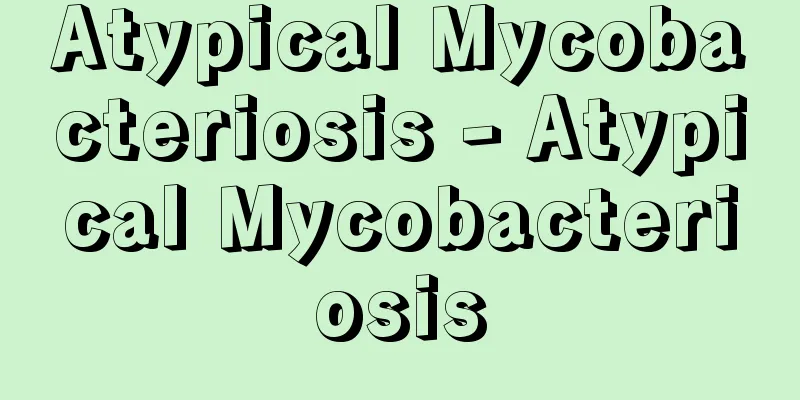Atypical Mycobacteriosis - Atypical Mycobacteriosis

|
[What kind of disease is it?] This disease mainly affects the lungs and is also called Nontuberculous Mycobacteriosis. Atypical acid-fast bacteria are a type of acid-fast bacteria that are resistant to acids, just like tuberculosis bacteria. They usually live in nature, such as in soil or water, but it is thought that infection occurs when bacteria accidentally fly through the air and are inhaled into the lungs, or come into contact with the skin from water. Since it is not transmitted from person to person, there is no need to isolate patients. There are many different types of atypical mycobacteria, and the organs affected, the symptoms, and the treatments vary. The main species are Mycobacterium avium, Mycobacterium intracellulare, and Mycobacterium kansasii. Because Mycobacterium avium and Mycobacterium intracellulare are very similar, they are often classified together as Mycobacterium avium-intracellulare complex type bacteria. It is said that this causes about 70% of atypical mycobacteriosis, and the remaining 30% are caused by Mycobacterium kansasii. The incidence of this disease has been on the rise in recent years. In particular, tuberculosis caused by the B. avium intracellulare complex was found to occur in 4.53 patients per 100,000 people in a nationwide survey conducted between 1985 and 1990, accounting for approximately 10% of new tuberculosis cases. ● Infection and disease For many species of bacteria, it is thought that infection occurs when the bacteria settles in the lungs and produces granulomas (pulmonary tuberculosis), but how the disease develops is not yet fully understood. Kansasii disease, caused by Burkholderia kansasii, is similar to tuberculosis in the way it develops and the shape of the lesions. The disease is most often seen in people who have had or currently have lung diseases such as tuberculosis or bronchiectasis, and it is believed that the bacteria preferentially infects weakened lungs. However, a small number of people who have been apparently healthy have also developed the disease. People with weakened immune systems are also susceptible to H. avium intracellulare complex disease, and it can rarely develop into a systemic disease like miliary tuberculosis (column "Miliary tuberculosis"). Currently, in Europe and the United States, it is a major problem because it is more likely to develop in people with AIDS ("AIDS/HIV infection") who have weakened immune systems. [Symptoms] There are no specific symptoms for lung lesions caused by atypical mycobacteria. The main symptoms are coughing, phlegm, bloody phlegm, fever, and weight loss, but since the virulence of the bacteria is weaker than that of tuberculosis, the symptoms are often mild. Kansasii disease is overwhelmingly more prevalent in men. There is no gender predilection for the onset of C. avium intracellulare complex disease, and most cases occur in middle-aged and elderly people, with the 60s being the most susceptible age group. [Testing and diagnosis] The tests are similar to those for tuberculosis, but atypical acid-fast bacteria cannot be distinguished from tuberculosis bacteria using acid-fast staining, which is used to detect tuberculosis bacteria. When a niacin test is performed on cultured bacteria, tuberculosis bacteria will test positive and atypical mycobacteria will test negative, making it possible to distinguish between them. In addition, the DNA of the bacteria is examined, and the characteristics of the cultured bacterial colonies are tested using various methods. Chest X-ray examinations show that in patients with Kansasiiosis, a shadow indicating a cavity in the upper part of the lung is often seen, just like in cases of tuberculosis. However, the walls of the cavity tend to be thinner than in cases of tuberculosis, and there tend to be fewer scattered shadows around it. On the other hand, the shadows of C. avium intracellulare complex disease are very diverse because they are influenced by existing lung lesions. In women, it begins as a shadow showing a nodule in the middle and lower part of the front of the lung (the part called the middle lobe in the right lung and the lingular region in the left lung), and is characterized by a slow progression in many cases. Unlike tuberculosis, atypical mycobacterial infection rarely causes pleural effusion and is said to not cause calcification of lung tissue. The tuberculin skin reaction for tuberculosis is not useful for determining whether or not atypical acid-fast bacteria are infected. Therefore, research is being conducted to create PPD (a test solution that induces a tuberculin skin reaction) from atypical acid-fast bacteria, but it has not yet been established. [Treatment] As with tuberculosis, combination therapy using anti-tuberculosis drugs is used. However, the type and effectiveness of the drugs chosen vary depending on the strain of the bacteria. The effectiveness of drugs against M. kansasii is similar to that of M. tuberculosis, and rifampicin (RFP) and ethionamide (TH) are the most effective. As with tuberculosis, most people will be cured if they continue a combination therapy of three drugs, isonicotinic acid hydrazide (INH), rifampicin, and ethambutol (EB), for one year. However, drugs are not effective against C. avium intracellulare complex bacteria, and the susceptibility test to examine the effectiveness of drugs by culturing them is unreliable. Currently, the antibiotic clarithromycin (CAM) is considered to be the most effective single drug. Currently, the most effective combination therapy is expected to be a combination of three to five drugs, consisting of clarithromycin and two to four of the anti-tuberculosis drugs kanamycin (KM), rifampicin, ethambutol, ethionamide, and cycloserine (CS). However, even with combination therapy for one to two years, complete recovery is difficult, and the disease is likely to worsen if treatment is stopped. If the affected area is limited, a combination drug therapy may be used to suppress the disease, and then surgery may be performed to remove the lesion, potentially resulting in a complete recovery. [Precautions in daily life] If symptoms are mild, you can live a normal life, but many medications put a strain on the liver, so you should refrain from drinking alcohol. If symptoms are severe, consult with a doctor. For those who are suffering from severe exhaustion, rest and nutrition are important. If breathing difficulties or coughing up blood are severe, hospitalization may be considered. [prevention] Prevention is virtually impossible, but for AIDS patients in particular, it is said that the avium intracellulare complex bacteria are likely to enter the body through the digestive tract, so eating raw fish and shellfish and swimming should be avoided. Source: Shogakukan Home Medical Library Information |
|
[どんな病気か] おもに肺がおかされる病気で、非結核性抗酸菌症(ひけっかくせいこうさんきんしょう)(Nontuberculous Mycobacteriosis)ともいいます。非定型抗酸菌は、結核菌と同様、酸などに強い抗酸菌のなかまです。ふだんは土壌や水中など自然界で生きていますが、たまたま空中に飛んでいたのが肺に吸い込まれたり、水から皮膚についたりして感染するのではないかと考えられています。人から人へは感染しないので、患者さんを隔離する必要はありません。 非定型抗酸菌といっても、さまざまな菌があり、おかされる臓器、発病のようす、治療法がそれぞれ異なります。おもな菌種は、アビウム菌、イントラセルラーレ菌、カンサシイ菌です。 アビウム菌とイントラセルラーレ菌はよく似ているので、一括してアビウム‐イントラセルラーレ・コンプレックス型菌と分類されることが多く、非定型抗酸菌症の約7割がこれによっておこり、あとの約3割がカンサシイ菌でおこるといわれています。 この病気は、近年、増加する傾向にあり、とくにアビウム‐イントラセルラーレ・コンプレックス型菌によるものは、1985~90年にかけて行なわれた全国調査で、人口10万人あたり4.53人の患者さんがおり、これは、新たに発生した結核患者さんの約10%にあたります。 ●感染と発病 多くの菌種で、菌が肺に定着して肉芽腫(にくげしゅ)(肺結核(「肺結核」))をつくり感染が成立すると考えられますが、どのように発病するかなど、まだよくわかっていません。 カンサシイ菌によるカンサシイ症は、発病のしかたや病変の形が、結核と似ています。 アビウム‐イントラセルラーレ・コンプレックス症では、結核や気管支拡張症(きかんしかくちょうしょう)など、肺の病気をしたことのある人や現在病気の人が発病することが多く、このため菌は肺の弱っているところに好んで感染するものと考えられています。しかし、少数ながら、明らかに健康であった人にも発病しています。 アビウム‐イントラセルラーレ・コンプレックス症は、全身の抵抗力の落ちた人も発症しやすく、粟粒結核(ぞくりゅうけっかく)(コラム「粟粒結核」)のような、全身性の病変をおこすこともまれにあります。現在、欧米では免疫抵抗力の落ちたエイズ(「エイズ/HIV感染症」)の人に発病しやすいため、大きな問題となっています。 [症状] 非定型抗酸菌症の肺病変に特有な症状というものはありません。せき、たん、血(けっ)たん、発熱、体重の減少がおもな症状ですが、結核に比べて菌の毒力が弱いため、症状は軽いことが多いようです。 カンサシイ症は、圧倒的に男性に多くみられます。アビウム‐イントラセルラーレ・コンプレックス症では発症の男女差はなく、ほとんどの場合、中高年に発病し、60歳代がもっともかかりやすい年齢です。 [検査と診断] 結核と同様の検査をしますが、非定型抗酸菌は結核菌を検出する抗酸性染色では、結核菌と区別がつきません。 培養した菌で、ナイアシン試験を行なうと、結核菌は陽性に、非定型抗酸菌は陰性になるので、区別できます。 さらに、菌のDNAを調べたり、培養した菌の群落の性質をいろいろな方法で検査して判定します。 胸部X線検査では、カンサシイ症の場合、結核と同じように、肺の上方に空洞(くうどう)を示す陰影がよく見られますが、結核よりも空洞の壁が薄く、周囲の散布陰影が少ない傾向があります。 一方、アビウム‐イントラセルラーレ・コンプレックス症の陰影は、もともとあった肺病変の影響を受けるため、非常に多彩です。女性では、肺の前方で中下方の部位(右肺では中葉(ちゅうよう)、左肺では舌区(ぜつく)といわれる部位)に、結節(けっせつ)を示す陰影として始まり、ゆっくり進行するタイプが多いのが特徴です。 非定型抗酸菌症は、結核とちがい胸水(きょうすい)がたまることはまれで、肺の組織の石灰化もきたさないといわれています。 結核のツベルクリン皮内反応(ひないはんのう)は、非定型抗酸菌の感染の判定には役立ちません。そのため、非定型抗酸菌からPPD(ツベルクリン皮内反応をおこす検査液)をつくる研究は行なわれていますが、現在まだ確立されていません。 [治療] 結核と同じように、抗結核薬を組み合わせた併用療法を行ないます。しかし、菌種によって選択する薬の種類や効きめが異なります。 カンサシイ菌は、薬の効き方が結核菌と似ていて、リファンピシン(RFP)とエチオナミド(TH)がもっともよく効きます。結核と同じように、イソニコチン酸ヒドラジド(INH)、リファンピシン、エタンブトール(EB)の3種の薬の併用療法を1年間続ければ、ほとんどの人は完治します。 しかし、アビウム‐イントラセルラーレ・コンプレックス菌は、薬が効きにくく、培養して薬の効果を調べる感受性試験もあてになりません。現在、抗生物質のクラリスロマイシン(CAM)が、単独の薬剤としては、もっとも有効とされています。 クラリスロマイシンに、抗結核薬のカナマイシン(KM)、リファンピシン、エタンブトール、エチオナミド、サイクロセリン(CS)のうち2~4剤を加えた3~5種の薬の多剤併用療法が、現在もっとも効果が期待されています。 しかし、1~2年間、併用療法をしても、完治はむずかしく、治療をやめると、病気が悪化しやすいのです。 病変部がかぎられていれば、まず多剤併用療法を行なって病気を抑え込み、その後、手術によって病変を除去すれば、完治する可能性もあります。 [日常生活の注意] 症状が軽ければ、ふつうに生活してかまいませんが、肝臓に負担のかかる薬が多いので、飲酒は控えます。症状が強い人は医師とよく相談しましょう。消耗が激しい人は、安静と栄養補給がたいせつです。呼吸困難や喀血(かっけつ)がひどいときは、入院も考えます。 [予防] 予防はまず不可能ですが、エイズの患者さんにかぎっては、アビウム‐イントラセルラーレ・コンプレックス型菌が消化管から侵入しやすいといわれているので、魚貝類の生食や水泳は避けるべきでしょう。 出典 小学館家庭医学館について 情報 |
Recommend
Ale (alcohol) - Ale
...The participants sacrificed livestock to the g...
Uzbek Khan - Uzbek Khan
...The next Khan, Mangu Timur (1266-82), interven...
Autumnal equinox - Shubunten
〘Noun〙 The point where the ecliptic and the celest...
breakbone fever
...The virus is a flavivirus 15-33 nm long, and a...
Kaivalya - Kaibaruya
...In Buddhism, this true knowledge is called enl...
"Abridgement of the Gyozan Kenmitsu Shomei Mantra" - Gyosan Kenmitsu Shomei Mantra
...A collection of Tendai chanting songs. It has ...
talking drum
...Tom Tom is said to be of African or Oriental o...
NGC663 - NGC663
…R Cassiopeiae, located near the border with Andr...
Dayflower - Dayflower
It is an annual plant of the Commelinaceae family...
Secret - Onmitsu
〘noun〙① (adjective) (━suru) To keep something hidd...
Johns Hopkins University - Johns Hopkins University
A private university with its headquarters in Balt...
Melton (English spelling)
A type of woolen fabric. It is woven in a plain or...
Gomi Yasusuke - Garbage Yasusuke
1921-1980 A novelist from the late Showa period. ...
Fukumitsu [town] - Fukumitsu
A former town in Nishitonami County in western Toy...
Belief in the guardian deity
Banshin is an abbreviation of Sanjubanshin. It is ...









